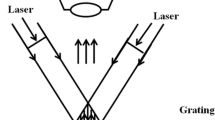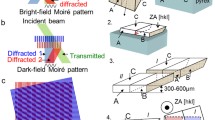Abstract
Moiré techniques were developed, adapted and applied to the determination of strain fields in filamentary composite laminates. Conventional techniques, using 1000 line-per-inch (Ipi) arrays bonded or photoprinted onto the specimen, were applied to glass-epoxy and boron-epoxy specimens with holes and cracks. Techniques for tenfold fringe multiplication were also applied to glass-epoxy and boron-epoxy laminates with holes. A reflective surface of glass-like smoothness was produced on the specimen and a 500 dot-per-inch grid photoprinted on it. A rigid distortion-free camera was used for recording replicas of the specimen grid by projection photography. These replicas were analyzed with a 200 line-per-millimeter (5080 Ipi) grating for reconstruction of moiré-fringe patterns. These patterns were analyzed by graphical and mechanical differentiation using second-order moiré. Strain distributions and strain-concentration factors were in very good agreement with theoretical and other experimental results.
Similar content being viewed by others
References
Daniel, I. M. and Rowlands, R. E., “Experimental Stress Analysis of Composite Materials,” ASME Paper No. 72-DE-6, presented at Design Engineering Conference, Chicago, IL, (May 8–11, 1972).
Daniel, I. M., Mullineaux, J. L., Ahimaz, F. J. and Liber, T., “The Embedded Strain Gage Technique for Testing Boron-Epoxy Composites,” Composite Materials: Testing and Design (Second Conference), ASTM STP497, 257–272 (1972).
Dally, J. W. andAlfirevich, I., “Application of Birefringent Coatings to Glass-fiber-reinforced Plastics,”Experimental mechanics,9 (3),97–102 (1969).
Rowlands, R. E., Daniel, I. M. andWhiteside, J. B., “Stress and Failure Analysis of a Glass-Epoxy Composite Plate with a Hole,”Experimental mechanics,13 (1),31–37 (1973).
Daniel, I. M., Rowlands, R. E. and Whiteside, J. B., “Deformation and Failure of Boron-Epoxy Plate with Circular Hole,” presented at ASTM Symposium on Analysis of Test Methods for High Modulus Fibers and Composites, San Antonio, TX (April 12–13, 1972).
Rowlands, R. E. andDaniel, I. M., “Application of Holography to Anisotropic Composite Plates,”Experimental mechanics,12, (2),75–82 (1972).
Armenakas, A. E., Garg, S. K., Sciammarella, C. A. andSvalbonas, V., “Experimental Study of the Failure Mechanism and Strength Characteristics of Fiber Bundles and Composites,”Experimental mechanics,12 (1),1–10 (1972).
Daniel, I. M. andRowlands, R. E., “Determination of Strain Concentration in Composites by Moiré Techniques,”J. of Comp. Matl.,5,250–254 (April1971).
Pipes, R. B. andDaniel, I. M., “Moiré Analysis of the Interlaminar Shear Edge Effect in Laminated Composites,”J. of Comp. Matl.,5,255–259 (April1971).
Sciammarella, C. A., “Techniques of Fringe Interpolation in Moiré Patterns,”Experimental mechanics,7 (11)19A-30A (1967).
Sciammarella, C. A. andSturgeon, D. L., “Digital-filtering Techniques Applied to the Interpolation of Moiré-fringe Data,”Experimental mechanics,7 (11),468–475 (1967).
Sampson, R. C. andCampbell, D. M., “The Grid-shift Technique for Moiré Analysis of Strain in Solid Propellants,”Experimental mechanics,7, (11),449–457 (1967).
Chiang, F. P., Parks, V. J. andDurelli, A. J., “Moiré-fringe Interpolation and Multiplication by Fringe Shifting,”Experimental mechanics,8 (12),554–560 (1968).
Post, D., “Analysis of Moiré Fringe Multiplication Phenomena,”Appl. Opt.,6 (11),1938–1942 (1967).
Post, D., “New Optical Methods of Moiré Fringe Multiplication,”Experimental mechanics,8 (2),63–68 (1968).
Post, D., “Moiré Fringe Multiplication with a Non-symmetrical Doubly-Blazed Reference Grating,”Appl. Opt.,10, (4),901–907 (April1971).
Post, D. andMacLaughlin, T. F., “Strain Analysis by Moiré-fringe Multiplication,”Experimental mechanics,11 (9),408–413 (1971).
Kodak Photosensitive Resists for Industry, Kodak Publication No. P-7.
Duncan, J. P. andSabin, P. G., “An Experimental Method for Recording Curvature Contours in Flexed Elastic Plates,”Experimental mechanics 5 (1),22–28 (1965).
Durelli, A. J., “Visual Representation of Kinematics of the Continuum,”Experimental mechanics,6 (3),113–139 (1966).
Lekhnitskii, S. G., Theory of Elasticity of Anisotropic Elastic Body, transl. by P. Fern, ed. by J. J. Brandstatter, Holden-Day, Inc., San Francisco (1963).
Savin, G. N., Stress Concentrations Around Holes, Pergamon Press (1961).
Author information
Authors and Affiliations
Rights and permissions
About this article
Cite this article
Daniel, I.M., Rowlands, R.E. & Post, D. Strain analysis of composites by moiré methods. Experimental Mechanics 13, 246–252 (1973). https://doi.org/10.1007/BF02322621
Issue Date:
DOI: https://doi.org/10.1007/BF02322621




